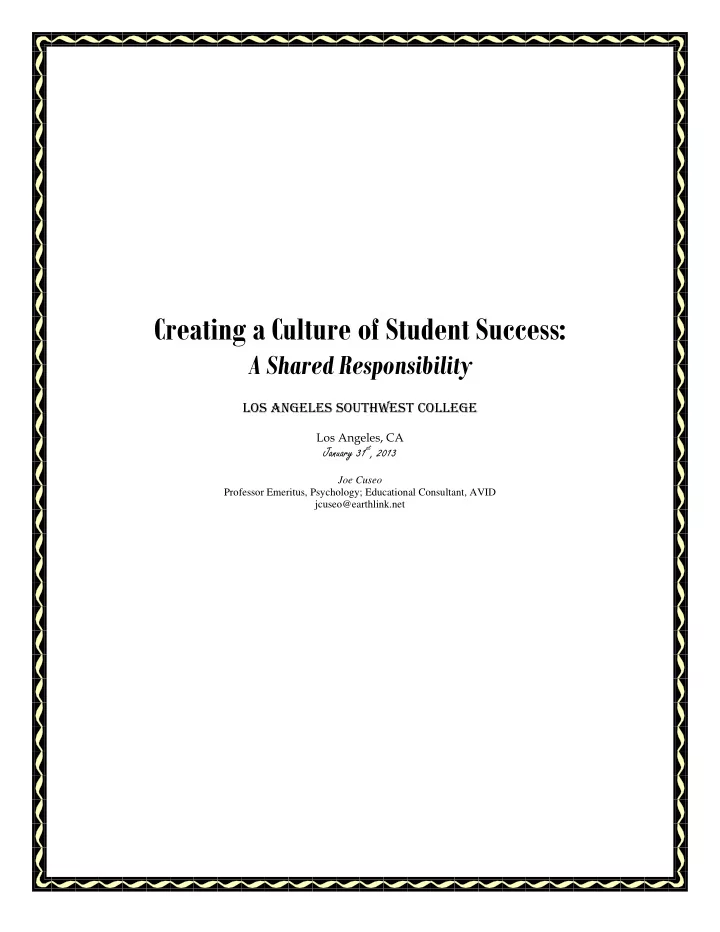

Creating a Culture of Student Success: A Shared Responsibility Los AngeLes southwest coLLege Los Angeles, CA January 31 st , 2013 Joe Cuseo Professor Emeritus, Psychology; Educational Consultant, AVID jcuseo@earthlink.net
2 Defining Student Success (& College Quality): 1. Student success and college quality are inextricably interrelated: Undergraduate success depends on both student effort and institutional effort , i.e., it involves a reciprocal relationship between what the college does for its students and what students do for themselves . 2. Quality undergraduate education should be defined in terms of: (a) what the college actually does with and for the undergraduates it enrolls—i.e., effective educational processes/practices/policies ), and (b) the type of students the college turns out ( positive student outcomes ) relative to the type of students it lets in—i.e., “talent development” or “value-added” assessment. ------------------------------------------------------------------------------------------------------------ Talent Development, a.k.a., Value-Added Assessment The I-E-O Model INPUT Incoming Characteristics of Students at College Entry (e.g., academic preparedness; family income; family’s prior college experience) ⇓ ENVIRONMENT (a.k.a., Environmental Input) Students’ Experiences at the College (Inside and Outside the Classroom) ⇓ OUTPUT Student Outcomes : Student characteristics at college exit (completion)—relative to their characteristics at college entry (matriculation) --------------------------------------------------------------------------------------------------------------------------------- Reference: Astin, A. W. (1991). Assessment for excellence: The philosophy and practice for assessment and evaluation in higher education . New York: Macmillan. Measuring Student Success and College Quality: Key Performance Indicators & Student Outcomes 1. Student Retention ( Persistence ): Percentage of entering students that remain, re-enroll, and continue to make progress toward degree completion.
3 2. Educational Attainment (Completion): Percentage of entering students that persist in college until they reach their intended degree, program, or educational goal. 3. Academic Achievement : The quantity/quality (nature) of student learning and cognitive development that takes place during the college experience—particularly deep learning (beyond memorization), durable learning (beyond the test), higher-order thinking skills (critical/creative thinking), and communication skills (written/oral). 4. Personal Development : Holistic (whole-person) development and learning that occurs during the college experience—e.g., identity formation, character development, social and emotional intelligence, diversity tolerance/appreciation, civic responsibility, and leadership. 5. Student Advancement : What students aspire to do, proceed to do, and succeed at doing beyond college completion—e.g., educational and/or occupational plans, placement, performance and advancement. --------------------------------------------------------------------------------------------------------------------------------- Appendix Key Properties/Principles of Effective Educational Programs & Student-Success Initiatives 1. INTENTIONAL (PURPOSEFUL) : They are deliberately designed and delivered with research-based principles of student success in mind, namely: * Personal Validation. * Self-Efficacy, * Active Involvement (Engagement), * Personal Meaning, * Social Integration, * Personal Reflection, and * Self-Awareness. 2. STUDENT-CENTERED : They are centered on and driven by the educational needs and personal welfare of students, rather than by institutional habit or convenience, or by the self-serving needs and preferences of faculty, administrators, or staff. 3. MISSION-DRIVEN : They are grounded in and guided by a well-articulated program mission that is consistent with the college or university mission . 4. INTRUSIVE : They are not offered passively on a come-find-and-use basis, i.e., waiting and hoping that students will discover and capitalize on them (“passive programming”); instead, supportive action is initiated by the institution by actively reaching out to students and bringing its services to them, thereby ensuring that support reaches students who are unlikely to seek it out on their own. 5 . PROACTIVE : They take early, preventative action that address students’ learning needs and developmental adjustments in an anticipatory fashion— before they eventuate in problems that require reactive (after-the-fact) intervention. 6 . DIVERSIFIED : They are tailored or customized to meet the distinctive needs of different student subpopulations (first-year students, underrepresented students, transfer students, etc.) 7. COMPREHENSIVE (HOLISTIC) : They focus on the student as a “ whole person,” addressing the
4 multiple dimensions of self that affect student success (social, emotional, physical, etc.). 8. DEVELOPMENTAL : They are delivered in a timely, stage-sensitive sequence that helps students accommodate challenges as they emerge at successive stages of the college experience, providing students a “scaffold” that balances challenge with just-in-time support . 9. COLLABORATIVE : They involve cooperative alliances or partnerships between different organizational units of the college/university, which work together in a complementary and interdependent manner, harnessing their collective power to exert synergistic (multiplicative) effects on student success. 10. SYSTEMIC : They occupy a central (rather than a peripheral or marginal) place on campus, which positions them to produce a pervasive effect on the student body and the potential to exert transformative effects on the institution itself. 11. DURABLE : They are institutionalized— i.e., they’re built or weaved into the fabric of the institution (e.g. its table of organization and annual budget process), thus ensuring the program’s longevity and its capacity to exert perennial impact on successive cohorts of students across an extended period of time. 12. EMPIRICAL (EVIDENTIARY) : They are supported by assessment data (both quantitative and qualitative), which are used for summative evaluation — to “sum up” and prove the program’s overall impact or value, and formative evaluation — to “shape up” and continually improve program quality. Go Cougars!
Recommend
More recommend